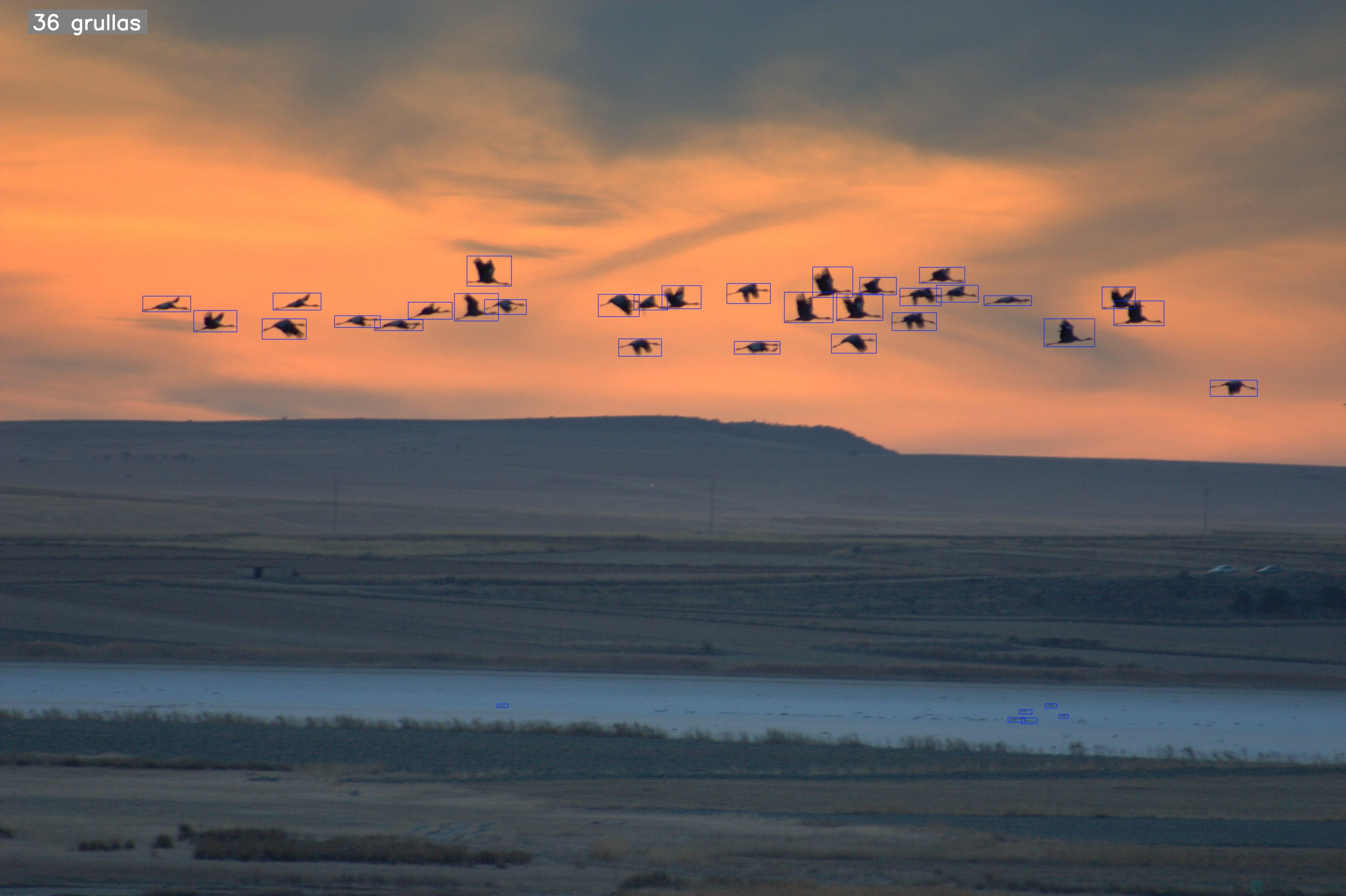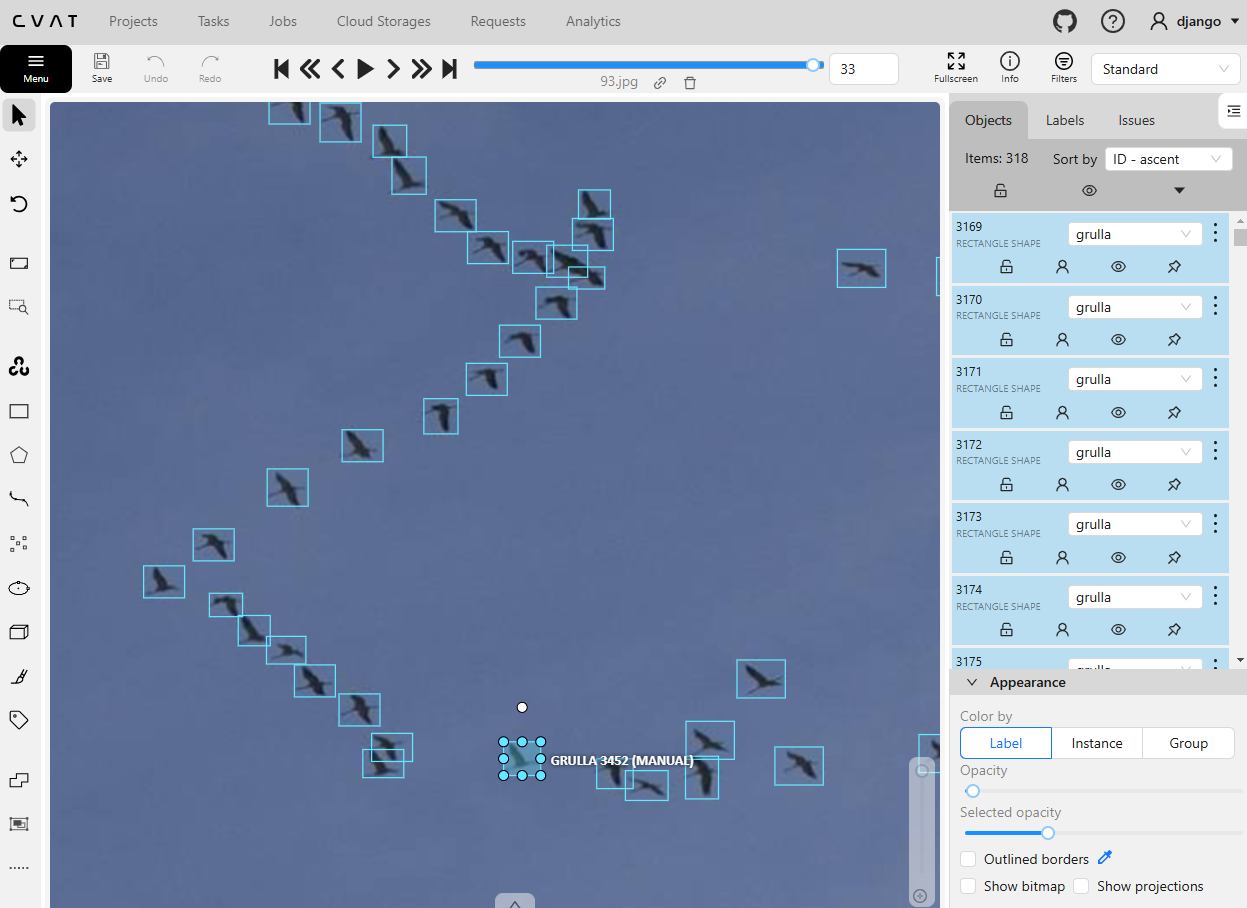GalloConta is a computer vision tool created to monitor the crane population at the Gallocanta Lake.
The lake is one of Spain’s most important bird sanctuaries. It serves as a critical stop for cranes during their migration.
This app helps automate crane counting, aiding researchers and conservationists in tracking the species with greater efficiency and accuracy.

Contents
Dataset
The dataset consists of 165 images of crane flocks donated by local nature photographers. The images, each 2048x2048 pixels, are split into three subsets:
- 113 training images
- 33 validation images
- 19 test images
Annotations were made using CVAT, a tool that simplifies the image labeling process.

How to use CVAT:
If you want to explore CVAT, you can follow the installation guide here:
Installing CVAT on Windows
Model
The app uses our GRULLA model, based on the YOLOv11 architecture, for detecting and counting cranes. YOLO is an advanced object detection model known for its accuracy and speed in real-time applications.
Model Training:
Here is the code used for training the model:
from ultralytics import YOLO
import os
data_dir = '/dataset'
output_dir = '/model'
model = YOLO('yolo11n.pt')
model.train(
data=f"{data_dir}/dataset.yaml",
epochs=600,
imgsz=2048,
batch=6,
save=True,
warmup_epochs=0,
project=output_dir,
name='grulla',
exist_ok=True,
)
Training Results:
The model’s training performance, including metrics, is detailed below:
Ultralytics 8.3.65 🚀 Python-3.11.11 torch-2.5.1+cu121 CUDA:0 (NVIDIA A100-SXM4-40GB, 40514MiB)
Class Images Instances P R mAP50 mAP50-95
all 33 3524 0.846 0.723 0.81 0.529

Test Metrics:
The model’s performance on the test subset is shown in the metrics below:
Ultralytics 8.3.65 🚀 Python-3.11.11 torch-2.5.1+cu121 CUDA:0 (NVIDIA A100-SXM4-40GB, 40514MiB)
Class Images Instances P R mAP50 mAP50-95
all 19 2103 0.936 0.831 0.89 0.666
Architecture
The application is built with FastAPI, a modern, high-performance web framework for building APIs with Python. It is deployed on Google Cloud Run, enabling fast, scalable, and serverless execution.
API Endpoints
The app provides three real-time endpoints:
/upload – Users can upload images to receive crane counting predictions.
/feedback – Users can submit feedback on the accuracy of the predictions.
/update – The model can be updated automatically from Kaggle, integrating the latest training improvements.
User Interface
A simple and responsive web interface is available in the galloconta-client repository on GitHub. Built with Next.js and deployed on Vercel, it allows users to upload images, view predictions with zoom, adjust model parameters, and submit feedback—all connected seamlessly to the FastAPI backend.
You can try it live at: galloconta.vercel.app
Video Inference
Here is the code used for video inference demo:
from ultralytics import YOLO
from ultralytics.solutions import object_counter
import ffmpeg
import cv2
input_path='video.mp4'
output_path='video.avi'
model_path='GRULLA.pt'
probe = ffmpeg.probe(video_path, v='error', select_streams='v:0', show_entries='stream=width,height')
width = probe['streams'][0]['width']
height = probe['streams'][0]['height']
cap = cv2.VideoCapture(input_path)
assert cap.isOpened(), "Error reading video file"
w, h, fps = (int(cap.get(x)) for x in (cv2.CAP_PROP_FRAME_WIDTH, cv2.CAP_PROP_FRAME_HEIGHT, cv2.CAP_PROP_FPS))
region_points = [(100, 0), (100, height)]
video_writer = cv2.VideoWriter(output_path, cv2.VideoWriter_fourcc(*"mp4v"), fps, (w, h))
counter = object_counter.ObjectCounter(
show=False,
region=region_points,
model=model_path,
show_in=True,
show_out=True,
line_width=1,
conf=0.17,
iou=0.55
)
while cap.isOpened():
success, im0 = cap.read()
if not success:
print("Video frame is empty or video processing has been successfully completed.")
break
im0 = counter.count(im0)
video_writer.write(im0)
cap.release()
video_writer.release()
cv2.destroyAllWindows()
Acknowledgements
Thanks to the photographers who donated images for the dataset: